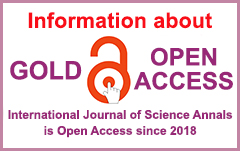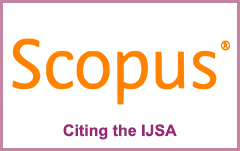| 1 University of Sfax, Tunisia |
Abstract
Background and Aim of Study: As the pandemic escalated into a global health crisis with abundant reports, updates and personal stories invading the World Wide Web and the social media, the context of COVID-19 offered for researchers an opportunity exploring the cyberchondria concept. Surprisingly, despite its prominence, the consequences of this shift in health behavior are still not fully appreciated. For many cyberchondriacs, the online shopping experience is considered as a coping strategy.
The aim of the study: to investigate how excessive health-related anxiety leads to online shopping enjoyment, and to examine the mediating roles of COVID-19 fear and hedonic shopping motivation.
Material and Methods: A survey methodology is used to collect responses from a sample of 355 consumers in Tunisia and analyzed via AMOS 23. Structural equation modeling was used to assess the causal relationship between measured variables.
Results: Our results indicate that during the current pandemic, the cyberchondria was associated with an increased online shopping enjoyment guided both by a developed fear from this virus and some of the hedonic motivations.
Conclusions: This study is one of the first studies that investigate the impact of cyberchondria on shopping experiences. Our findings may indicate starting points for some public health marketers and managers to make interventions to reduce cyberchondria during the pandemic. Particularly, online shopping may be considered as a safe space, where anxious people may escape. However, public health organizations should carefully consider these outcomes of cyberchondria and should elucidate clear pathways of action so that consumers feel empowered to tackle the pandemic effectively.
Ahorsu, D. K., Lin, C. Y., Imani, V., Saffari, M., Griffiths, M. D., & Pakpour, A. H. (2020, March 27). The fear of COVID-19 scale: Development and initial validation. International Journal of Mental Health and Addiction. https://doi.org/10.1007/s11469-020-00270-8
Ali, A., Li, C., Hussain, A., & Bakhtawar. (2020, August 28). Hedonic shopping motivations and obsessive-compulsive buying on the Internet. Global Business Review. https://doi.org/10.1177/0972150920937535
Arnold, M. J., & Reynolds, K. E. (2003). Hedonic shopping motivations. Journal of Retailing, 79(2), 77–95. https://doi.org/10.1016/S0022-4359(03)00007-1
Arnold, M. J., & Reynolds, K. E. (2012). Approach and avoidance motivation: Investigating hedonic consumption in a retail setting. Journal of Retailing, 88(3), 399–411. https://doi.org/10.1016/j.jretai.2011.12.004
Babin, B. J., Darden, W. R., & Griffin, M. (1994). Work and/or fun: Measuring hedonic and utilitarian shopping value. Journal of Consumer Research, 20(4), 644–656. https://doi.org/10.1086/209376
Bajaj, B., Robins, R. W., & Pande, N. (2016). Mediating role of self-esteem on the relationship between mindfulness, anxiety, and depression. Personality and Individual Differences, 96, 127–131. https://doi.org/10.1016/j.paid.2016.02.085
Bajcar, B., & Babiak, J. (2021). Self-esteem and cyberchondria: The mediation effects of health anxiety and obsessive-compulsive symptoms in a community sample. Current Psychology, 40, 2820–2831. https://doi.org/10.1007/s12144-019-00216-x
Barke, A., Bleichhardt, G., Rief, W., & Doering, B. K. (2016). The Cyberchondria Severity Scale (CSS): German validation and development of a short form. International Journal of Behavioral Medicine, 23(5), 595–605. https://doi.org/10.1007/s12529-016-9549-8
Byrne, B. M. (2001). Structural equation modeling with AMOS, EQS, and LISREL: Comparative approaches to testing for the factorial validity of a measuring instrument. International Journal of Testing, 1(1), 55–86. https://doi.org/10.1207/S15327574IJT0101_4
Diallo, M. F., & Seck, A. M. (2018). How store service quality affects attitude toward store brands in emerging countries: Effects of brand cues and the cultural context. Journal of Business Research, 86, 311–320. https://doi.org/10.1016/j.jbusres.2017.08.017
Doherty-Torstrick, E. R., Walton, K. E., & Fallon, B. A. (2016). Cyberchondria: Parsing health anxiety from online behavior. Psychosomatics, 57(4), 390–400. https://doi.org/10.1016/j.psym.2016.02.002
Fornell, C., & Larcker, D. F. (1981). Evaluating structural equation models with unobservable variables and measurement error. Journal of Marketing Research, 18(1), 39–50. https://doi.org/10.1177/002224378101800104
Garfin, D. R., Silver, R. C., & Holman, E. A. (2020). The novel coronavirus (COVID-2019) outbreak: Amplification of public health consequences by media exposure. Health Psychology, 39(5), 355–357. https://doi.org/10.1037/hea0000875
Gioia, F., & Boursier, V. (2020). What does predict cyberchondria? Evidence from a sample of women. Journal of Psychology and Psychotherapy Research, 7, 68–75. https://doi.org/10.12974/2313-1047.2020.07.6
Hashemi, S. G. S., Hosseinnezhad, S., Dini, S., Griffiths, M. D., Lin, C. Y., & Pakpour, A. H. (2020). The mediating effect of the cyberchondria and anxiety sensitivity in the association between problematic internet use, metacognition beliefs, and fear of COVID-19 among Iranian online population. Heliyon, 6(10), E05135. https://doi.org/10.1016/j.heliyon.2020.e05135
Horváth, C., & Adıgüzel, F. (2018). Shopping enjoyment to the extreme: Hedonic shopping motivations and compulsive buying in developed and emerging markets. Journal of Business Research, 86, 300–310. https://doi.org/10.1016/j.jbusres.2017.07.013
Huang, Y., & Zhao, N. (2020). Generalized anxiety disorder, depressive symptoms and sleep quality during COVID-19 outbreak in China: A web-based cross-sectional survey. Psychiatry Research, 288, Article 112954. https://doi.org/10.1016/j.psychres.2020.112954
Jungmann, S. M., & Witthöft, M. (2020). Health anxiety, cyberchondria, and coping in the current COVID-19 pandemic: Which factors are related to coronavirus anxiety? Journal of Anxiety Disorders, 73, Article 102239. https://doi.org/10.1016/j.janxdis.2020.102239
Laato, S., Islam, A. N., Farooq, A., & Dhir, A. (2020). Unusual purchasing behavior during the early stages of the COVID-19 pandemic: The stimulus-organism-response approach. Journal of Retailing and Consumer Services, 57, Article 102224. https://doi.org/10.1016/j.jretconser.2020.102224
Lee, K., Hoti, K., Hughes, J. D., & Emmerton, L. (2014). Dr Google and the consumer: A qualitative study exploring the navigational needs and online health information-seeking behaviors of consumers with chronic health conditions. Journal of Medical Internet Research, 16(12), e262. https://doi.org/10.2196/jmir.3706
Lee, E., & Lee, H. (2019). Disaster awareness and coping: Impact on stress, anxiety, and depression. Perspectives in Psychiatric Care, 55(2), 311–318. https://doi.org/10.1111/ppc.12351
Loos, A. (2013). Cyberchondria: Too much information for the health anxious patient? Journal of Consumer Health on the Internet, 17(4), 439–445. https://doi.org/10.1080/15398285.2013.833452
McElroy, E., Kearney, M., Touhey, J., Evans, J., Cooke, Y., & Shevlin, M. (2019). The CSS-12: Development and validation of a short-form version of the cyberchondria severity scale. Cyberpsychology, Behavior, and Social Networking, 22(5), 330–335. https://doi.org/10.1089/cyber.2018.0624
McManus, F., Leung, C., Muse, K., & Williams, J. M. G. (2014). Understanding “cyberchondria”: An interpretive phenomenological analysis of the purpose, methods and impact of seeking health information online for those with health anxiety. The Cognitive Behaviour Therapist, 7, E21. https://doi.org/10.1017/S1754470X14000270
Mohammed, D., Wilcox, S., Renee, C., Janke, C., Jarrett, N., Evangelopoulos, A., Serrano, C., Tabassum, N., Turner, N., Theodore, M., Dusic, A., & Zeine, R. (2019). Cyberchondria: Implications of online behavior and health anxiety as determinants. Archives of Medicine and Health Sciences, 7(2), 154–162. https://doi.org/10.4103/amhs.amhs_108_19
Norr, A. M., Allan, N. P., Boffa, J. W., Raines, A. M., & Schmidt, N. B. (2015). Validation of the Cyberchondria Severity Scale (CSS): Replication and extension with bifactor modeling. Journal of Anxiety Disorders, 31, 58–64. https://doi.org/10.1016/j.janxdis.2015.02.001
Podsakoff, P. M., MacKenzie, S. B., Lee, J. Y., & Podsakoff, N. P. (2003). Common method biases in behavioral research: A critical review of the literature and recommended remedies. Journal of Applied Psychology, 88(5), 879–903. https://doi.org/10.1037/0021-9010.88.5.879
Preacher, K. J., Rucker, D. D., & Hayes, A. F. (2007). Addressing moderated mediation hypotheses: Theory, methods, and prescriptions. Multivariate Behavioral Research, 42(1), 185–227. https://doi.org/10.1080/00273170701341316
Starcevic, V., & Berle, D. (2013). Cyberchondria: Towards a better understanding of excessive health-related Internet use. Expert Review of Neurotherapeutics, 13(2), 205–213. https://doi.org/10.1586/ern.12.162
Wang, E., An, N., Gao, Z., Kiprop, E., & Geng, X. (2020). Consumer food stockpiling behavior and willingness to pay for food reserves in COVID-19. Food Security, 12(4), 739–747. https://doi.org/10.1007/s12571-020-01092-1
White, R. W., & Horvitz, E. (2009). Cyberchondria: Studies of the escalation of medical concerns in web search. ACM Transactions on Information Systems, 27(4), Article 23. https://doi.org/10.1145/1629096.1629101
Xiao, H., Zhang, Y., Kong, D., Li, S., & Yang, N. (2020). Social capital and sleep quality in individuals who self-isolated for 14 days during the coronavirus disease 2019 (COVID-19) Outbreak in January 2020 in China. Medical Science Monitor, 26, e923921. https://doi.org/10.12659/MSM.923921
Zhang, Y., & Ma, Z. F. (2020). Impact of the COVID-19 pandemic on mental health and quality of life among local residents in Liaoning Province, China: A cross-sectional study. International Journal of Environmental Research and Public Health, 17(7), Article 2381. https://doi.org/10.3390/ijerph17072381
Zhao, X., Lynch, Jr. J. G., & Chen, Q. (2010). Reconsidering Baron and Kenny: Myths and truths about mediation analysis. Journal of Consumer Research, 37(2), 197–206. https://doi.org/10.1086/651257
Masmoudi Manel Hakim – https://orcid.org/0000-0001-7902-7094;
| |
APA
Masmoudi, M. H. (2021). “Looking for fun or escaping the fear?” How can COVID-19 cyberchondriacs enjoy the online shopping during the pandemic. International Journal of Science Annals, 4(2), 37–45. https://doi.org/10.26697/ijsa.2021.2.4
Harvard
Masmoudi, M. H., 2021. "“Looking for fun or escaping the fear?” How can COVID-19 cyberchondriacs enjoy the online shopping during the pandemic". International Journal of Science Annals, [online] 4(2), pp. 37-45. viewed 25 December 2021, https://culturehealth.org/ijsa_archive/ijsa.2021.2.4.pdfVancouver
Masmoudi M. H. “Looking for fun or escaping the fear?” How can COVID-19 cyberchondriacs enjoy the online shopping during the pandemic. International Journal of Science Annals [Internet]. 2021 [cited 25 December 2021]; 4(2): 37-45. Available from: https://culturehealth.org/ijsa_archive/ijsa.2021.2.4.pdf https://doi.org/10.26697/ijsa.2021.2.4












